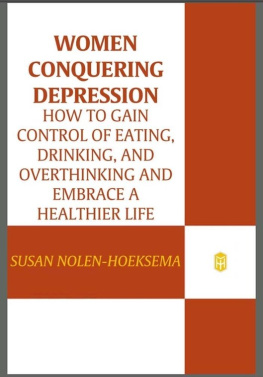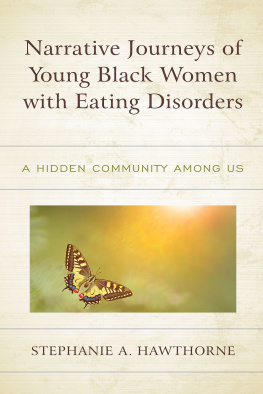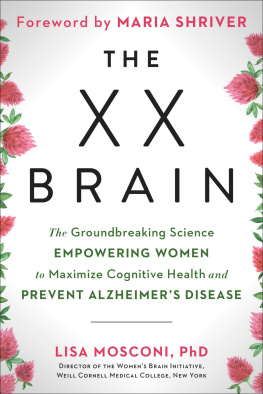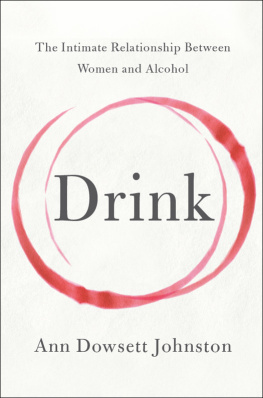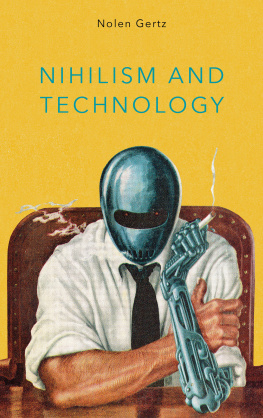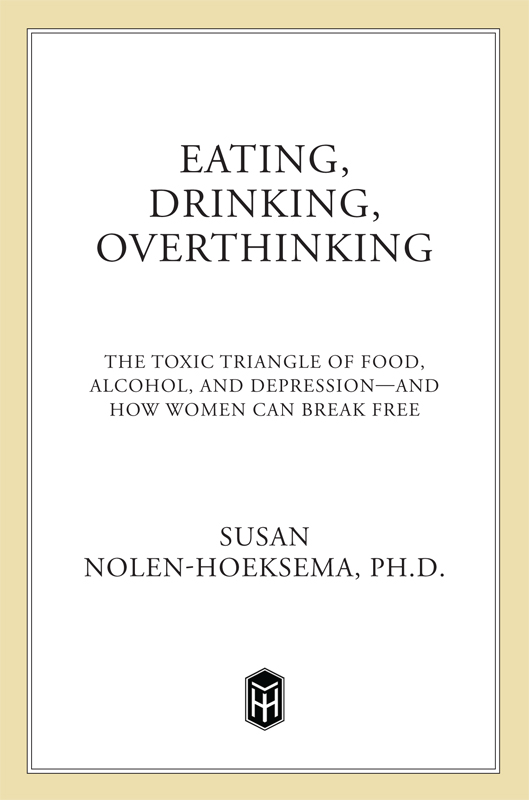
The author and publisher have provided this e-book to you for your personal use only. You may not make this e-book publicly available in any way. Copyright infringement is against the law. If you believe the copy of this e-book you are reading infringes on the authors copyright, please notify the publisher at: us.macmillanusa.com/piracy.
Contents
In memory of Catherine Nolen
P REFACE
W OMENS MENTAL HEALTH has been my focus and my passion for over twenty years. Ive spent the bulk of my career researching and publishing articles on womens mental health in the scientific literature. In 2003, I first translated that research for the general public in Women Who Think Too Much: How to Break Free of Overthinking and Reclaim Your Life. In that book I described the phenomenon of overthinking, in which women become trapped in ruminations about the past, the present, and the future that can immobilize them and send them into the depths of depression.
In the few years since I wrote Women Who Think Too Much, I have become increasingly concerned with the broader picture of womens mental health and well-being. Overthinking and depression are indeed common and debilitating problems among women, but they are not the only ones. Depression rarely occurs in a vacuum. Instead, as my research has found, it usually occurs alongside other symptoms, and these often involve food or alcohol.
Depressive symptoms, unhealthy eating habits, and heavy drinking can unite to create a space so poisonous for women that I have called it the toxic triangle. Women enter the toxic triangle on many different pathways: some by way of depressive symptoms that they try to smother in food or drown in alcohol; some by way of crazy dieting or binge eating, which tears down their self-esteem, sending them plummeting into depression or alcohol abuse; and others by way of drinking, either to please a man or to ease stress, though it appears to set women up for depression and yo-yo eating patterns.
Eating, Drinking, Overthinking will help you understand your own relationship to the toxic triangle. This book is not just for women who are already aware that they suffer from clinical depression, diagnosed eating disorders, or alcoholism. It is for those who dance around the edges of the toxic triangle, with moderate symptoms of depression, unhealthy eating patterns, or moderate to heavy patterns of drinking. My research shows that there are millions of women who engage in this dance over the course of their lives. Unfortunately, my research also shows that even mild symptoms of depression, eating disorders, or alcohol abusenot to mention the confluence of all threecan be toxic to womens mental well-being, their physical health, their relationships, and their careers. When the three elements of the toxic triangle intersect, women are pulled into a vortex of misery and self-destruction so powerful that they can find it very difficult to escape.
Escape is possible, however, and I will show you ways out of the toxic triangle. By transforming the very traits that make women vulnerable to the toxic triangle into strengths, we can pull ourselves out. Just as women are extraordinarily sensitive to our own emotions and the emotions of others, and deeply concerned about our relationships, we recognize that these traits can get us into trouble. This is because they so often lead us to engage in what I call self-focused coping: handling stressful situations by turning inward on ourselves rather than outward in an attempt to change the situation. Womens emotional and interpersonal sensitivities can, however, be harnessed to create more effective and healthy ways of coping with stress. Eating, Drinking, Overthinking will give you the tools to do this.
If you are a loved one or friend of a woman caught in the toxic triangle, this book will help you understand this deadly space, and how to help her escape it. In the final chapter, I discuss how we can start this effort early by helping girls and young women avoid the pathways that lead into the toxic triangle.
Eating, Drinking, Overthinking raises an alarm by revealing that the intersection of depression, unhealthy eating, and heavy drinking is as common in women as it has commonly been ignored by both scientists and the lay public. This book also gives hope to women caught in the triangle, as well as to their family and friends, that freedom from the toxic triangle is within our reach.
ONE
The Toxic Triangle
For Jill, a thirty-year-old account executive at a large bank, there were two distinct parts to each week. When she was on-duty, from Monday morning to Thursday night, she tightly controlled everything she ate and drank. Breakfast, if she ate it at all, was just a piece of toast with a bit of jam (no butter) and lots of black coffee. Lunch was always a small, pristine salad with no-cal dressing. Dinner was as sparse and low-fat as she could make it and still call it dinnerusually just a frozen diet entree. And alcohol never passed her lips while on-duty, no matter how much she wanted it. Even if she went out with clients to a nice restaurant, she ordered sparkling water, adopting an air of casual self-righteousness about her abstinence from alcohol.
By Thursday night, however, Jills cravings for food and drink were powerful. The sense of control and superiority that she gained from avoiding food and alcohol all week were overcome by feelings of frustration, longing, and defeat. Why wasnt she more fulfilled in her job? Could she really handle the stresses of her position? When was she ever going to find a man she could really fall in love with? And why did she have to deprive herself all the time just to stay skinny and put in long hours at work?
The second phase of Jills week, when she was off-duty, usually began slowly, on Thursday night. Shed come home from work, feeling tired but agitated, desperately wanting a drink. Just one drink, she told herself, I deserve it the way this week has gone. Shed pour herself a glass of sauvignon blanc and sip it slowly while she sorted through mail and microwaved her dinner. Oh damn, shed say, when the first glass was drained. Im not ready to eat yet. Then shed pour another glass, vowing that two was going to be her max, for sure. By the time dinner was ready and the second glass was empty, Jill was ravenous. And a diet entree out of the microwave was not what she wanted. She put the entree in the fridge and brought out the chips. I need some starch to soak up this wine, shed tell herself. Jill then took her chips, and another glass of wine, and flopped down on the couch to watch TV. It felt so good, such a relief, to let go and do what her mind and her body seemed to want to doeat and drink. Jill spent the rest of Thursday night snacking on junk food and leftovers and drinking more wine, until she collapsed into bed around midnight.
Of course, she felt terrible the next morning. But Fridays were usually absent of meetings, so she could hole up in her office, popping Advil while kicking herself for her indulgences the night before.
By Friday night, however, she was ready to party. It was the weekend, she was off-duty, and she wasnt going to waste a minute of it. From Fridays happy hour with workmates through a party on Saturday night, into Sundays get-together with friends to watch football, Jill raged. She ate anything she wanted tohamburgers and fries, fettuccine Alfredo, everything that she forbade herself while she was on-duty during the week. And she drank. Hard liquor, beer, wine, whatever was being served.


